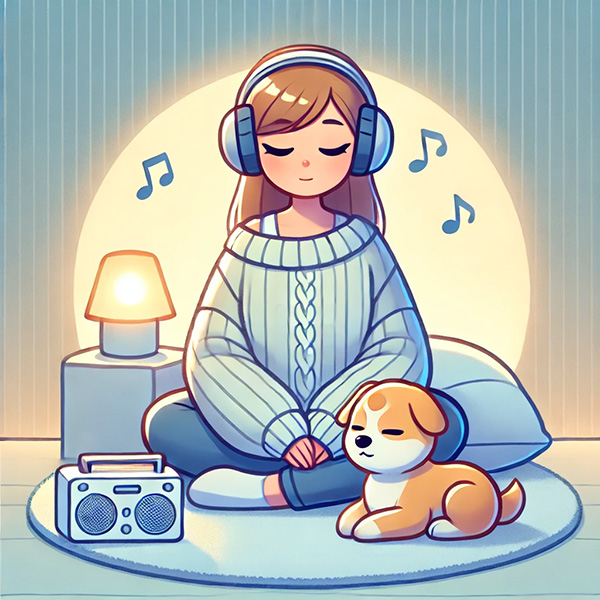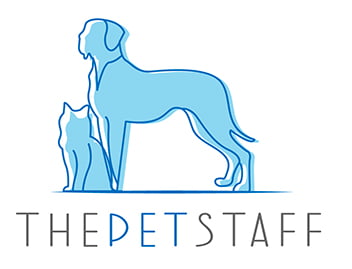Stress is not just a human issue; our canine companions experience it too, whether triggered by a change in environment, loud noises like fireworks, or even separation from their beloved human. But don’t worry! With a bit of understanding, learning to read dog body language and a lot of love, you can ease your dog's stress and improve their well-being. Below, I will share some ways for dog owners to help keep a dog calm and more comfortable.
Ways to Relieve Dog Stress
Creating a Safe Space

Creating a safe space for your dog is a powerful way to relieve stress and provide comfort during anxious moments and a place to escape from a stressful situation. A safe space is a specific area in your home where your dog can relax, feel secure, and be away from anything that might cause stress or overwhelm. Choose a quiet, low-traffic area, away from noise and foot traffic, such as a corner in a bedroom or a cozy spot in the living room. Placing a soft, comfortable bed or blanket in this area will give your dog a familiar, cozy retreat where they can rest. Adding familiar scents, like an old T-shirt, their favorite toys, or a blanket, can also help, as these familiar smells are comforting for dogs and can make the space feel more like a sanctuary.
If your dog is accustomed to a crate, use it as part of their safe space by leaving the door open, allowing them to come and go as they please and giving them the freedom to choose their comfort. Control the lighting and sound in the area by keeping it dimly lit and reducing outside noises. A white noise machine or soft, calming music can help mask loud or sudden sounds, especially during events like thunderstorms or fireworks. Additionally, calming tools like pheromone diffusers, which release synthetic dog-appeasing pheromones, can create a more soothing environment, such as chew toys or anxiety wraps for extra comfort.
Encourage your dog to use this space by leading them there during times of stress and offering treats, praise, or gentle petting to associate it with positive experiences. However, allow your dog to enter and leave the space on their own terms, respecting their boundaries. This sense of control reinforces that it’s a safe retreat they can turn to whenever they feel the need. Creating this calm, familiar environment with comforting elements gives your dog a powerful tool to help them manage stress and feel secure in their surroundings.
Create a Consistent Routine
Creating a consistent routine is one of the most effective ways to help relieve stress in dogs, as it provides them with a sense of stability and predictability. Dogs are creatures of habit who feel more secure and experience less anxiety when they know what to expect. By establishing regular times for feeding, walks, play, and rest, you create a structured environment that allows your dog to anticipate what’s coming next. This predictability can be especially comforting for an anxious dog or prone to stress in unfamiliar situations.
For example, feeding your dog at the same time every day not only satisfies their hunger but also strengthens their sense of routine. Scheduled walks and playtimes give your dog an outlet for energy and provide mental stimulation, which is crucial for reducing stress and preventing behavioral issues. A consistent bedtime and wake-up time also help regulate their internal clock, allowing them to feel more balanced and calm throughout the day.
In addition to daily activities, incorporating familiar commands and cues in your interactions can reinforce this routine and create positive associations. Using the same words or signals for activities like meals, walks, and play helps your dog understand what to expect and reduces the chance of confusion or stress. Even when changes to the routine are unavoidable, such as during travel or a new environment, keeping key routine elements—like feeding and bedtime—consistent can help your dog adapt more easily.
Provide Physical Exercise

Regular physical exercise is a great way to relieve stress in dogs, as it allows them to release pent-up energy, reduce anxiety, maintain good physical health, and feel happier overall. Dogs are inherently active and require regular exercise; without it, they may become frustrated, restless, and destructive. By giving your furry friend consistent opportunities to engage in physical activity, you help them stay fit and create a healthy outlet for their mental health and emotional energy, directly reducing stress.
Regular walks, runs, or playtime are crucial for helping your dog cope with stress. Walking exposes them to new sights, sounds, and smells, which is mentally stimulating and can be a form of stress relief in itself. For dogs with a lot of energy, activities like fetch, tug-of-war, or even agility training are excellent ways to give them a more intense workout. Creating an exercise routine based on your dog’s breed, age, and energy level ensures they receive the appropriate amount of activity without being overworked.
Exercise also triggers the release of endorphins, the body's natural "feel-good" chemicals, which enhance mood and reduce stress. Dogs that get sufficient exercise are often calmer and more relaxed at home, as they’ve had an opportunity to work off any tension or anxiety. Physical exercise as a regular part of your dog’s daily routine contributes to a balanced lifestyle that promotes overall well-being, helping them feel more comfortable and secure.
Provide Mental Stimulation
Providing mental stimulation is an effective way to relieve stress in dogs. It stimulates their minds, alleviates boredom, and directs their energy into positive outlets. Just like physical exercise, mental activity is crucial for a dog’s well-being. When mentally stimulated, dogs are less likely to feel anxious, frustrated, or resort to destructive behaviors, as they have a constructive outlet for their natural curiosity and intelligence.
You can incorporate mental stimulation into your dog’s daily routine in various ways. For instance, puzzle toys and slow feeders encourage your dog to solve a problem to earn a treat, offering entertainment and a reward. Interactive or food-dispensing toys keep their minds engaged, making feeding time more interesting. Training sessions provide another great opportunity to engage your dog mentally. Teaching new tricks or reinforcing basic commands provides structure, builds confidence, and strengthens the bond between you and your dog. Even short training sessions can make a significant impact by giving your dog a sense of accomplishment.
Scent-based activities, like hiding treats around the house for them to find, engage their natural instincts and help maintain their focus. Rotating toys or introducing new ones periodically can also keep your dog’s environment interesting and mentally engaging. For high-energy breeds, activities like agility courses or obedience training add an extra level of mental and physical challenge.
Using Calming Aids
Using calming aids can be an effective way to help relieve stress in dogs, especially in situations where a dog's anxiety is high, such as during thunderstorms, fireworks, travel, or visits to the vet. Calming aids come in various forms and can help soothe your dog and reduce the pet's stress levels, making them feel more secure and comfortable. Here’s a look at some commonly used calming aids and how they work:
Pheromone Diffusers and Sprays

Pheromone-based calming aids mimic the natural pheromones that a mother dog releases to comfort her puppies. Products like Adaptil diffusers, sprays, and collars release these synthetic pheromones into the air, creating a calming environment that can reduce the dog's anxiety and make your dog feel more at ease. These aids are especially useful for dogs who experience separation anxiety or are nervous in new environments.
Calming Chews and Treats
Many calming chews and treats contain natural ingredients like chamomile, valerian root, L-tryptophan, and melatonin, known for their calming effects. These supplements help relax your dog without causing sedation. Calming chews can be helpful before stressful events or for dogs who experience general anxiety. It’s best to consult your vet before introducing any calming supplements to ensure they’re safe and appropriate for your dog.
Anxiety Wraps and ThunderShirts
Like the ThunderShirt, anxiety wraps apply gentle, consistent pressure around your dog’s torso, similar to swaddling a baby. The gentle pressure provides a soothing effect, helping to alleviate anxiety and encourage relaxation. Anxiety wraps are particularly helpful for dogs with noise sensitivities or those who are stressed during travel. They are easy to use and can be worn during any situation where your dog might feel anxious.
Calming Music or White Noise

Soft, soothing music or white noise can mask external sounds that may trigger anxiety, such as fireworks or traffic. Many pet owners discover that playing classical music or using white noise machines can help create a peaceful atmosphere that relaxes their dogs. There are even playlists and apps designed specifically with calming music for dogs, which can be especially effective in providing a relaxing atmosphere.
Herbal Supplements and Essential Oils
Some herbal supplements and essential oils, such as lavender, are recognized for their calming effects. However, it's important to use essential oils carefully, as some may be harmful to pets. Always dilute the oils and avoid applying them directly to your dog. Instead, a few drops in a diffuser or placing them in an area your dog can avoid if they choose may be helpful. Herbal supplements like valerian or chamomile may also promote relaxation, but consult with your vet before use.
Crate Covers or Darkened Spaces

Creating a safe, quiet, and dimly lit area can be very soothing for stressed dogs. Using a crate cover or setting up a cozy corner with blankets and low lighting can create a sense of security, making your dog feel protected. Crate-trained dogs may find this particularly comforting.
Calming aids can be used alone or combined with behavior training to help manage anxiety more effectively. These tools don’t replace long-term solutions, such as positive reinforcement and training, but they can provide immediate relief and help your dog feel more comfortable in challenging situations. Before introducing new calming aids, consult your veterinarian to ensure they are appropriate for your dog's needs and health conditions.
